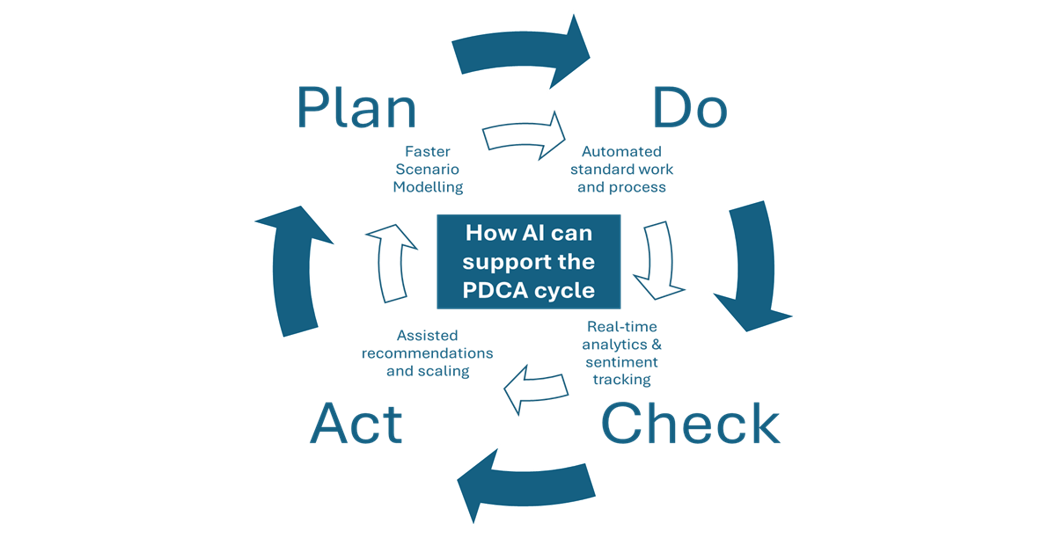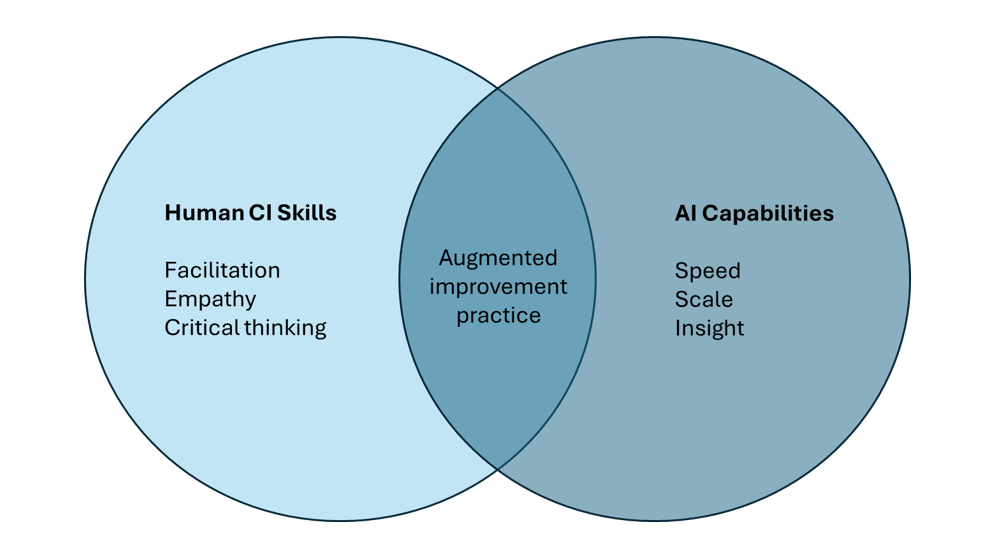How AI Enhances the Improvement Profession
In our Whitepaper, ‘Adapt or Be Automated: What AI Means for Improvement Professionals’, we explored the threats and opportunities facing the profession.
In this series of 3 blogs, we will be exploring the key elements of this paper in a bit more detail. The first blog explored a 9-point checklist aimed at helping CI Leaders take a structured approach to embedding AI into the organisation’s operating model.
In this second blog, we will look in more detail at why CI professionals should be embracing AI, and how it can enhance their existing approach and toolkit.
Why CI Professionals Should Care
CI professionals are uniquely positioned at the intersection of process, culture, and strategy. They are both facilitators of structured problem-solving and custodians of improvement culture. This dual role means they will be among the first to feel both the benefits and the risks of AI:
| Benefits | Risks |
| Accelerate scenario modelling | Reinforce bias |
| Provide deeper customer insight | Erode stakeholder trust |
| Improve compliance | Defer judgement |
| Reduce administrative burden | Dull critical thinking |
| Scale training and development | Data Security & Breaches |
For CI professionals, the challenge is not whether AI will change their work, but how they will choose to respond now. They can remain passive, waiting for technology to be imposed upon them, or they can position themselves as trailblazers in responsible adoption. Like the pioneers of Lean who once introduced standard work and visual management to new audiences, today’s CI leaders have the opportunity to shape how AI is applied, governed, and integrated into the DNA of organisational improvement.
AI presents improvement professionals with a powerful new toolkit. Its ability to process information at scale, generate insights, and automate routine tasks is already transforming how organisations operate. For CI practitioners, the benefits are not abstract, they are emerging daily across sectors, pointing to real opportunities to expand reach, accelerate impact, and deepen customer and organisational understanding. While risks remain, the advantages of thoughtful adoption are compelling.
Speed and Efficiency Gains
One of the most immediate benefits of AI is its capacity to streamline repetitive and administrative tasks. In process-heavy environments, AI can dramatically reduce the time spent on low-value activities such as collating data, handling routine complaints, or triaging requests.
Across the public sector, AI is being used to reduce cumbersome administrative tasks which previously absorbed thousands of staff hours. The result, huge efficiency gains allowing professionals to redirect time towards value-added activity and improving the customer experience. In healthcare, this means utilising AI to summarise case notes and triaging patient data, allowing clinicians to focus more on patient care.
Conversations with improvement leads in the manufacturing sector highlight how AI is supporting visual inspections and predictive maintenance. This is resulting in process faults being identified earlier, a reduction in costs and downtime.
Another example applicable in all sectors is the automation of customer complaint handling. Harnessing AI within this process can lead to reduced administrative tasks and more consistent customer experiences, enabling staff to focus on addressing the root cause of the complaint.
Whilst Lean tools are used to reveal hidden waste, these examples illustrate AI’s role in removing waste to drive innovation at scale and enable accelerated improvement cycles. This leaves people to focus on higher-value activities such as facilitation, stakeholder engagement, and continuous improvement.
Beyond efficiency, AI offers a step-change in analytical capability. By sifting through vast datasets, it can reveal trends, risks, and opportunities that would otherwise be invisible to human analysis, reimagining the way we approach problem solving; AI enriches CI judgment by making insight immediate and actionable.
This is already transforming risk modelling and compliance by improving accuracy and speed. Public sector strategists report that AI can test multiple future scenarios rapidly, allowing leaders to compare options that previously required weeks of manual analysis. Operational insights from customer-facing industries show how AI is being applied to predict customer behaviours, providing a sharper basis for decision-making and highlighting when intervention will improve satisfaction and limit churn.
For CI professionals, the implication is clear; decision-making and problem solving can be enhanced by AI’s capacity to synthesise complex information. However, the role of the improvement practitioner is not diminished, it is redefined. The value lies not in producing data outputs, but in interpreting, challenging, and framing them within the organisational context.
Scaling Capability Across the Organisation
One of the historic limitations of improvement practice has been the ability to scale expertise across large organisations; AI presents opportunities to extend reach and consistency in ways previously unimaginable.
Education sector insights illustrate this vividly. AI tutors and adaptive learning platforms are being used to tailor learning to individual students while maintaining consistency in delivery. For organisations, the same approach could be applied to training in CI methods, providing a scalable but personalised model of learning.
Cross-sector leaders emphasise that AI can also support CI facilitators by creating simulations, generating role-play scenarios, or providing first-draft reports, thereby enabling practitioners to serve more teams in parallel. More importantly, it strengthens the consistent application of Standard Work, ensuring that best practice is not only documented but reinforced across the organisation. In this sense, AI becomes a “force multiplier” for improvement professionals, amplifying their ability to build capability at scale without compromising quality.
Enhanced Customer Understanding Through the Voice of the Customer
AI is transforming how organisations capture and respond to the Voice of the Customer (VoC). Traditional VoC methods such as surveys, interviews, and complaints data provide valuable insight, but are limited by scale and frequency. AI tools extend this capability dramatically, enabling organisations to analyse patterns in behaviour, sentiment, and feedback in real time and at volumes that would previously have been impossible to process.
In finance, for example, AI-driven compliance systems are tailoring interventions to individual customer circumstances, ensuring that responses are not only efficient but aligned with customer needs and expectations. In operational contexts, AI is used to surface unmet needs or detect friction points in customer journeys that might otherwise remain hidden, providing a richer foundation for targeted improvement.
For CI professionals, the integration of AI with VoC offers both opportunity and responsibility. It means designing improvements not only for process efficiency but for genuine customer impact, with data-driven insights highlighting where customers feel most valued or most frustrated. Yet it also requires maintaining empathy and context. AI may identify patterns, but it cannot replace the human skills of listening, interpreting nuance, and engaging directly with customers to validate and understand their lived experiences. In this sense, personalisation becomes a core component of process improvement. By marrying the analytical power of AI with the empathy and contextual awareness of CI practice, professionals can ensure that the customer’s voice remains at the heart of improvement, amplified rather than obscured by technology.
Case Study – When Does a Human Need to Perform the Role?
Customer Experience in Pet Insurance
Imagine working in a pet insurance company. A customer calls because their pet is seriously ill. In theory, a virtual agent could handle the interaction, answering FAQs and suggesting next steps. But AI cannot convey empathy or understand the emotional weight of such a call. In this moment, the customer wants not only a quick resolution, but also compassion from a human agent. That is what creates memorable service.
Contrast this with a routine password or account reset. Here, AI can resolve the issue instantly, and the customer is unlikely to value a human agent’s involvement. By allowing AI to handle simple first-line queries, service teams can be redeployed to more complex and emotionally significant interactions. The result, a better customer experience, and more meaningful, developmental roles for employees.
A New Lens on Professional Value
Taken together, these benefits challenge improvement professionals to rethink their own value proposition. If AI can produce faster analysis and broader insight, the differentiator for CI will be in human-centred skills like facilitation, interpretation, and ethical judgement.
The competitive edge lies not in resisting technology, but in ensuring it augments human creativity and criticality. By embracing AI as a partner in Lean practice, one that can accelerate PDCA cycles, strengthen Standard Work, and amplify the Voice of the Customer, CI practitioners can move from being data-crunchers to becoming strategic facilitators of organisational learning. In doing so, they ensure that AI enhances rather than diminishes the very principles at the heart of continuous improvement.
How AI can support the PDCA cycle.
Augment, Do not Replace: The Hybrid Future of Improvement
The future of AI in Continuous Improvement will not be one of wholesale replacement. AI is most powerful when used as an assistant, while CI professionals pioneer how technology augments human capability. The profession’s value lies not in competing with machines for answers, but in guiding how those answers are used.
CI practitioners therefore need to function as critical filters. Tools such as A3 problem-solving provide the rigour that prevents over-reliance on AI outputs. By framing the right questions, validating insights, and contextualising results, improvement leaders ensure that AI generated work strengthens rather than weakens decision-making.
 The human dimension must also remain central. AI can accelerate the capture of the Voice of the Customer, but it cannot interpret nuance or build empathy. Similarly, it can enhance and scale Standard Work, but only people can conduct a waste walk, feel cultural nuances, and motivate colleagues. These human-centred skills are where CI professionals add distinctive value.
The human dimension must also remain central. AI can accelerate the capture of the Voice of the Customer, but it cannot interpret nuance or build empathy. Similarly, it can enhance and scale Standard Work, but only people can conduct a waste walk, feel cultural nuances, and motivate colleagues. These human-centred skills are where CI professionals add distinctive value.
Trust is another critical factor. “Black box” decisions, where stakeholders cannot see how conclusions are reached, risk eroding confidence. CI leaders must help make AI use transparent, ensuring clarity around why, when, and how AI supports improvement.
AI alone cannot deliver sustainable improvement. Success lies in a hybrid model, where machines accelerate analysis whilst humans uphold reasoning, inclusiveness, and purpose. CI professionals who embrace this orchestration role will secure their place as leaders of socio-technical systems, ensuring technology augments rather than replaces.

A visual depiction of the CI Value Proposition with the augmentation of AI
This blog is part of our whitepaper ‘Adapt or Be Automated: What AI Means for Improvement Professionals’. You can download the full whitepaper below.






